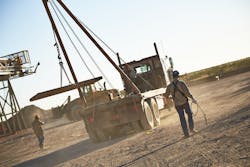Meeting conditions
If the words “field service fleet” make you think of service trades or utility operations, they take on an entirely new meaning at Wilbanks Energy Logistics, where assembling and hauling oil rigs is the core of the company’s business. The company, which was founded in 1987 as Wilbanks Trucking, today operates 120 vehicles from facilities in Artesia, Carlsbad and Hobbs, NM, and Midland/Odessa, TX.
“Our highly specialized vehicles haul oil field equipment from site to site across New Mexico and Texas within 150 mi. of each of our terminals,” explains COO Lance Wilbanks. “Every permitted load we carry is overweight and oversize, and we operate in open, mostly desert country where at least 30% of the roads we travel are unmaintained rough, dirt surfaces. The harsh conditions we face and the nature of our work can be very abusive to the equipment.”
The Wilbanks fleet consists mainly of Western Star 4900 tractors designed to handle 120,000- to 140,000-lb. loads and fitted with mechanical hydraulic winches used to disassemble, load and unload, and reassemble oil rigs. The double and triple frame heavy haul units are spec’d with Detroit DD15 500-hp. engines, Allison automatic transmissions, Sisu drive axles, and Hendrickson solid suspensions. Trailers in the fleet, supplied by Scona and Kalyn-Siebert, include 48-ft., two- to five-axle low boy units rated for loads as high as 80 tons.
Wilbanks is also presented with unique maintenance issues. “Dust is a big challenge,” Wilbanks relates. “We have a strict inspection routine for the shops at our terminals that calls for checking air filters weekly, and it’s not uncommon to change them every 30 days. Hauling heavy loads also means servicing brake systems fairly frequently.”
Driver training
The Wilbanks operation requires a special type of driver as well. “We generate a lot of exposure with oversize and overweight loads,” Wilbanks says. “It takes a high-caliber driver to handle the equipment. As a result, our training process is very stringent. Even a seasoned over-the-road driver needs six to 12 months to be eligible to operate some of our vehicles.”
Other driver-related issues that Wilbanks is addressing include recent changes to hours-of-service (HOS) regulations and the pending mandate for electronic onboard recorders (EOBRs). “Many of the oil field exceptions under HOS rules were discontinued when the new regulations took effect last year,” explains Wilbanks. “There are few exceptions left and an ongoing debate about whether our operations and equipment qualify for them.
“To that end,” Wilbanks continues, “we’ve developed a proprietary dispatch program that fits our business. It allows us to manage driver hours on job sites where they spend a majority of their time and while traveling to and from each location.
“We also decided to get ahead of the EOBR mandate for electronic logs by testing a few products,” he explains. “We now have good data on the options and should have the EOBR technology implemented by the beginning of July.”
Wilbanks is also using information management solutions technology for routing its highly specialized equipment and orchestrating and executing complex, challenging moves. Before each haul, a map of the planned route is generated and surveys are conducted to identify obstacles and hazards, especially power lines, that may become an issue with overheight loads.
“We’re firmly focused on all aspects of logistics to automate and streamline business processes, as well as the equipment it takes to get the job done,” says Wilbanks. “Our vision is to have the data we need about equipment, crews, operations, and projects readily accessible so we can continually analyze ways to improve efficiency.”
